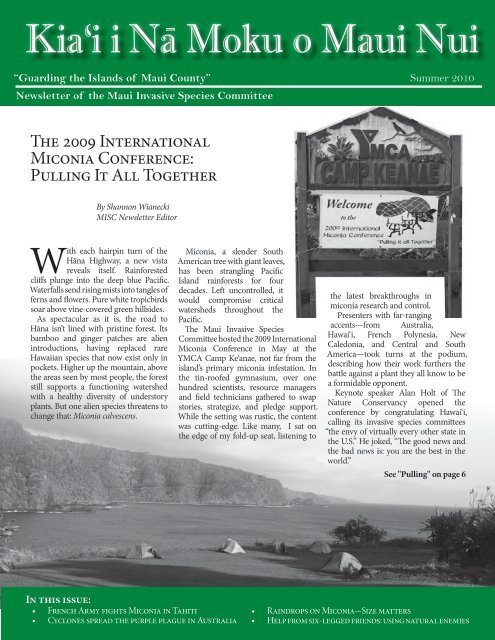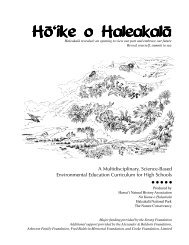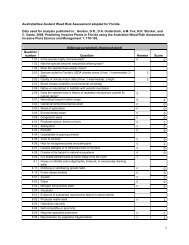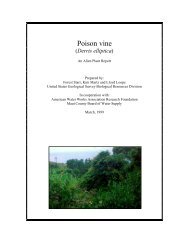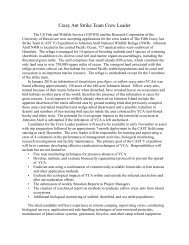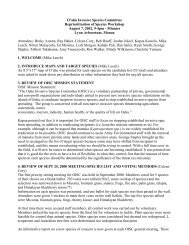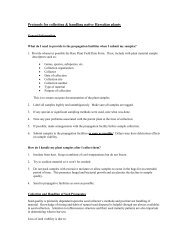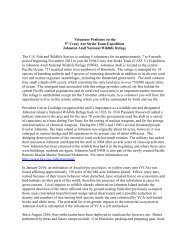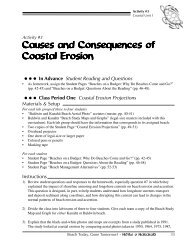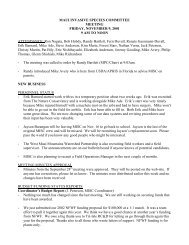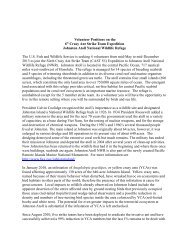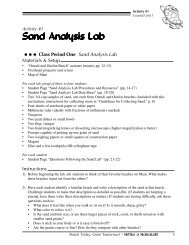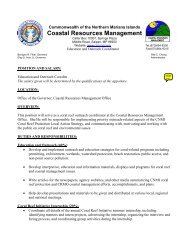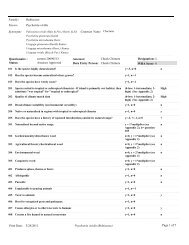Kiai i Na Moku o Maui Nui - Hawaiian Ecosystems at Risk project
Kiai i Na Moku o Maui Nui - Hawaiian Ecosystems at Risk project
Kiai i Na Moku o Maui Nui - Hawaiian Ecosystems at Risk project
You also want an ePaper? Increase the reach of your titles
YUMPU automatically turns print PDFs into web optimized ePapers that Google loves.
-<br />
Kia‘i i <strong>Na</strong> <strong>Moku</strong> o <strong>Maui</strong> <strong>Nui</strong><br />
“Guarding the Islands of <strong>Maui</strong> County”<br />
Newsletter of the <strong>Maui</strong> Invasive Species Committee<br />
Summer 2010<br />
The 2009 Intern<strong>at</strong>ional<br />
Miconia Conference:<br />
Pulling It All Together<br />
By Shannon Wianecki<br />
MISC Newsletter Editor<br />
With each hairpin turn of the<br />
Hāna Highway, a new vista<br />
reveals itself. Rainforested<br />
cliffs plunge into the deep blue Pacific.<br />
W<strong>at</strong>erfalls send rising mists into tangles of<br />
ferns and flowers. Pure white tropicbirds<br />
soar above vine-covered green hillsides.<br />
As spectacular as it is, the road to<br />
Hāna isn’t lined with pristine forest. Its<br />
bamboo and ginger p<strong>at</strong>ches are alien<br />
introductions, having replaced rare<br />
<strong>Hawaiian</strong> species th<strong>at</strong> now exist only in<br />
pockets. Higher up the mountain, above<br />
the areas seen by most people, the forest<br />
still supports a functioning w<strong>at</strong>ershed<br />
with a healthy diversity of understory<br />
plants. But one alien species thre<strong>at</strong>ens to<br />
change th<strong>at</strong>: Miconia calvescens.<br />
Miconia, a slender South<br />
American tree with giant leaves,<br />
has been strangling Pacific<br />
Island rainforests for four<br />
decades. Left uncontrolled, it<br />
would compromise critical<br />
w<strong>at</strong>ersheds throughout the<br />
Pacific.<br />
The <strong>Maui</strong> Invasive Species<br />
Committee hosted the 2009 Intern<strong>at</strong>ional<br />
Miconia Conference in May <strong>at</strong> the<br />
YMCA Camp Ke‘anae, not far from the<br />
island’s primary miconia infest<strong>at</strong>ion. In<br />
the tin-roofed gymnasium, over one<br />
hundred scientists, resource managers<br />
and field technicians g<strong>at</strong>hered to swap<br />
stories, str<strong>at</strong>egize, and pledge support.<br />
While the setting was rustic, the content<br />
was cutting-edge. Like many, I s<strong>at</strong> on<br />
the edge of my fold-up se<strong>at</strong>, listening to<br />
the l<strong>at</strong>est breakthroughs in<br />
miconia research and control.<br />
Presenters with far-ranging<br />
accents—from Australia,<br />
Hawai‘i, French Polynesia, New<br />
Caledonia, and Central and South<br />
America—took turns <strong>at</strong> the podium,<br />
describing how their work furthers the<br />
b<strong>at</strong>tle against a plant they all know to be<br />
a formidable opponent.<br />
Keynote speaker Alan Holt of The<br />
<strong>Na</strong>ture Conservancy opened the<br />
conference by congr<strong>at</strong>ul<strong>at</strong>ing Hawai‘i,<br />
calling its invasive species committees<br />
“the envy of virtually every other st<strong>at</strong>e in<br />
the U.S.” He joked, “The good news and<br />
the bad news is: you are the best in the<br />
world.”<br />
See "Pulling" on page 6<br />
In this issue:<br />
• French Army fights Miconia in Tahiti<br />
• Cyclones spread the purple plague in Australia<br />
• Raindrops on Miconia-Size m<strong>at</strong>ters<br />
• Help from six-legged friends: using n<strong>at</strong>ural enemies
Message from the Manager<br />
“Lacking any conference-hosting<br />
experience, intern<strong>at</strong>ional or otherwise,<br />
we thought, 'How hard could it be?'”<br />
By Teya Penniman<br />
MISC Manager<br />
Several years ago I <strong>at</strong>tended a public<br />
meeting where a local doctor<br />
likened a worrisome disease to<br />
miconia for its ability to spread quickly<br />
and cause devast<strong>at</strong>ion. I marveled th<strong>at</strong><br />
miconia had become an icon for things<br />
invasive. Perhaps it wasn’t so surprising.<br />
After all, we’ve been talking about<br />
miconia to anyone who will listen for<br />
nearly twenty years, ever since its initial<br />
detection in Hāna.<br />
We’re still talking about miconia, but<br />
the convers<strong>at</strong>ions documented in this<br />
newsletter are global in origin and<br />
focus. The voices come from the 2009<br />
Intern<strong>at</strong>ional Miconia Conference,<br />
hosted by MISC in May.<br />
We can credit Dr. Lloyd Loope for<br />
including the conference in a research<br />
proposal submitted to the Hawai‘i<br />
Invasive Species Council. Loope had<br />
particip<strong>at</strong>ed in the 1997 Tahiti miconia<br />
conference and thought it was time<br />
to review progress since then. We’re<br />
not sure whom to credit (blame?) for<br />
suggesting th<strong>at</strong> <strong>Maui</strong> host it. Lacking<br />
any conference-hosting experience,<br />
intern<strong>at</strong>ional or otherwise, we thought,<br />
“How hard could it be?”<br />
MISC partners and staff began to<br />
identify conference goals: bringing<br />
together the world’s experts on miconia,<br />
showcasing our work, and recognizing<br />
our partners. Perhaps most daunting,<br />
we wanted our intern<strong>at</strong>ional colleagues<br />
to see a miconia invasion on a <strong>Hawaiian</strong><br />
Island.<br />
Those goals—especially th<strong>at</strong> of<br />
hosting a massive work trip in<br />
miconia-infested forest—ruled out<br />
a resort-based conference. The only<br />
venue with adequ<strong>at</strong>e meeting space th<strong>at</strong><br />
could easily get us into the East <strong>Maui</strong><br />
infest<strong>at</strong>ion was the Ke‘anae YMCA:<br />
a campground loc<strong>at</strong>ed along <strong>Maui</strong>’s<br />
2<br />
rugged, rainy northern shore, equipped<br />
with dormitory-style bunkhouses, a<br />
commercial kitchen, and a sweeping<br />
view of the Ke‘anae peninsula. Not<br />
your typical meeting venue. And one<br />
th<strong>at</strong> several site visits proved could be<br />
a drenching, muddy mess. Undeterred,<br />
the committee dove in.<br />
We found a Hāna c<strong>at</strong>erer, tents,<br />
musicians and a hula hālau. We began<br />
stockpiling different sizes of pants,<br />
boots, shirts, and gloves, and blazing<br />
the word “miconia” on them in bright<br />
orange letters. We cre<strong>at</strong>ed a website.<br />
We asked for help covering additional<br />
costs. Dr. Loope invited key miconia<br />
researchers from across the Pacific and<br />
from miconia’s n<strong>at</strong>ive range, where<br />
research is occurring on biological<br />
control agents.<br />
To our delight, they came. One<br />
hundred and ten participants<br />
representing eight countries traveled<br />
vast distances to <strong>Maui</strong>. The audience<br />
was a veritable who’s who in <strong>Hawaiian</strong><br />
conserv<strong>at</strong>ion. Staff from all five Hawai‘i<br />
Invasive Species Committees came as<br />
well. They crammed into vans headed to<br />
Ke‘anae, pitched tents or claimed bunks,<br />
and settled in. Community members,<br />
local media, and elected officials also<br />
particip<strong>at</strong>ed in the four-day meeting.<br />
In retrospect, we were honored<br />
to host the conference. Thanks to<br />
outstanding we<strong>at</strong>her, a unique venue,<br />
diligent planning, ‘ono (delicious)<br />
c<strong>at</strong>ering, awesome vendors, generous<br />
financial support, and most importantly,<br />
the dynamic and knowledgeable<br />
<strong>at</strong>tendees, the 2009 Intern<strong>at</strong>ional<br />
Miconia Conference was a resounding<br />
success. I was left with a sense of shared<br />
commitment to protecting n<strong>at</strong>ive<br />
forests and w<strong>at</strong>ersheds across the Pacific,<br />
and gr<strong>at</strong>itude th<strong>at</strong> there is a whole lot<br />
more than just talk happening to stop<br />
the spread of miconia.<br />
The articles for this newsletter<br />
represent the breadth and quality of<br />
work occurring around the world<br />
on miconia. Eager for more? The<br />
proceedings from the conference will<br />
be available online <strong>at</strong> the conference<br />
website: www.hear.org/conferences/<br />
miconia2009. •<br />
Conference committee members: Teya Penniman, Perry Bednorz, Jeremy Gooding,<br />
Stuart Funke-d’Egnuff, Elizabeth Anderson, Tanya Vasquez, Brooke Mahnken, Lissa<br />
Fox, Lloyd Loope, and P<strong>at</strong> Bily (not pictured).
Conference Perspective<br />
"Guarding the Islands of <strong>Maui</strong><br />
County" is the official newsletter<br />
of the <strong>Maui</strong> Invasive Species<br />
Committee. To join our mailing<br />
list please call 573-6472 or email<br />
miscpr@hawaii.edu.<br />
The Time Seemed Right<br />
By Lloyd Loope, Ph.D.<br />
Research Scientist<br />
United St<strong>at</strong>es Geological Survey-Biological Resources Division<br />
Shannon Wianecki, Editor<br />
Lissa Fox, Design<br />
Contributors:<br />
Tom Giambelluca<br />
Lloyd Loope<br />
Brooke Mahnken<br />
Jean-Yves Meyer<br />
Helen Murphy<br />
Teya Penniman<br />
Shannon Wianecki<br />
Lissa Fox<br />
www.mauiisc.org<br />
miscpr@hawaii.edu<br />
P.O. Box 983<br />
Makawao, HI 96768<br />
The <strong>Maui</strong> Invasive Species<br />
Committee is a partnership of<br />
government, non-profit, and priv<strong>at</strong>e<br />
organiz<strong>at</strong>ions working to protect<br />
<strong>Maui</strong> County from the most harmful<br />
invasive plants and animals.<br />
MISC works to prevent invasive<br />
species from becoming established,<br />
controls invasive species on priv<strong>at</strong>e<br />
and public property free of charge,<br />
and educ<strong>at</strong>es people about how to<br />
protect <strong>Maui</strong> County.<br />
In September of 1980, I arrived on<br />
<strong>Maui</strong> with the challenging job of<br />
providing scientific support for<br />
Haleakalā <strong>Na</strong>tional Park’s long-term<br />
mission to protect <strong>Hawaiian</strong> plants and<br />
animals. During my first decade on<br />
<strong>Maui</strong>, insightful mentors and diverse<br />
experiences with invasive species<br />
honed my confidence in recognizing a<br />
mega-problem when I saw it.<br />
Miconia was already here but we<br />
didn’t know it. Park employee Betsy<br />
Gagné happened to spot a miconia<br />
tree on a Nāhiku roadside five miles<br />
from the Park, and in January of 1991,<br />
she and I embarked on a fact-finding<br />
mission to scope out the problem. Our<br />
discoveries th<strong>at</strong> day ultim<strong>at</strong>ely led to a<br />
st<strong>at</strong>ewide campaign against miconia.<br />
Nearly two decades l<strong>at</strong>er, I feel<br />
a deep responsibility for helping<br />
MISC and st<strong>at</strong>ewide partners forge a<br />
sustainable, long-term str<strong>at</strong>egy against<br />
this formidable weed tree. Miconia<br />
thre<strong>at</strong>ens to impoverish rainforest<br />
biodiversity and degrade w<strong>at</strong>ershed<br />
integrity. Given the substantial cost<br />
and complexity of the existing miconia<br />
control<br />
program,<br />
we need to<br />
continually<br />
refine our approach.<br />
Jean-Yves Meyer provided an<br />
inspiring example by hosting the First<br />
Miconia Control Conference in Tahiti<br />
in 1997. Ten years l<strong>at</strong>er, Jean-Yves and<br />
I were able to meet Australian scientists<br />
involved in miconia research <strong>at</strong> a major<br />
invasive plant conference in Australia.<br />
We realized th<strong>at</strong> the new ideas and<br />
wisdom coming from Australia could<br />
help inform the miconia control effort<br />
in the Pacific region. We also realized<br />
th<strong>at</strong> biocontrol efforts were in need<br />
of better understanding and support.<br />
When a funding opportunity arose,<br />
the time seemed right for a second<br />
conference to bring together the people<br />
with the best ideas in the science and<br />
management of miconia.<br />
The entire 2009 Intern<strong>at</strong>ional<br />
Miconia Conference was stimul<strong>at</strong>ing,<br />
but I most appreci<strong>at</strong>ed the reports of<br />
See "Time" on page 4<br />
3
Miconia, a plant out of place...<br />
Miconia is n<strong>at</strong>ive to the rainforests of Central and South America...<br />
...but has invaded<br />
tropical clim<strong>at</strong>es<br />
throughout<br />
the world<br />
✴<br />
Hawai‘i<br />
✴<br />
Sri Lanka<br />
✴<br />
✴<br />
Australia<br />
✴<br />
New Caledonia<br />
French Polynesia (Tahiti)<br />
"Time" continued from page 3<br />
Professors Robert Barreto from Brazil<br />
and Paul Hanson from Costa Rica. They<br />
were enlisted by University of Hawai‘i<br />
Professor Clifford Smith to engage<br />
students in finding and testing potential<br />
biological control agents. They searched<br />
in miconia’s n<strong>at</strong>ive range for n<strong>at</strong>ural<br />
enemies capable of neutralizing miconia<br />
invasions elsewhere. Reporting on ten<br />
to fifteen years of work, they effectively<br />
conveyed the sheer excitement of<br />
biological discovery. <strong>Hawaiian</strong> miconia<br />
field crew workers took in these<br />
present<strong>at</strong>ions with fascin<strong>at</strong>ion, while<br />
Barreto and Hanson were equally<br />
fascin<strong>at</strong>ed to see—for the first time—<br />
strikingly dense stands of miconia in<br />
<strong>Maui</strong>’s core infest<strong>at</strong>ion.<br />
4<br />
Simple containment of this fastspreading<br />
weed is so demanding th<strong>at</strong><br />
resources to address other thre<strong>at</strong>s<br />
are scarce. Increasing energy costs<br />
of the crucial helicopter surveillance<br />
and control of miconia are a worry. I<br />
believe we have to find a way to harness<br />
biological control toward an effective<br />
solution. An optimal transition from<br />
physical and chemical control to<br />
biological control is essential.<br />
Tracy Johnson of the U.S. Forest<br />
Service and Darcy Oishi of the Hawai‘i<br />
Department of Agriculture estim<strong>at</strong>ed<br />
th<strong>at</strong> a series of potentially effective<br />
biological control agents for miconia<br />
(including p<strong>at</strong>hogens and insects<br />
already well known from work in Costa<br />
Rica and Brazil) could be released in<br />
Hawai‘i within five to fifteen years. The<br />
timing will likely depend on the level<br />
of funding for testing within Hawai‘i.<br />
Unfortun<strong>at</strong>ely, the current economic<br />
recession challenges all aspects of<br />
miconia containment.<br />
The conference laid out wh<strong>at</strong> is needed<br />
for MISC – sustaining mechanical<br />
and chemical containment efforts in<br />
the short run, while finding ways to<br />
augment resources for an acceler<strong>at</strong>ed<br />
and effective biological control program.<br />
There is certainly no room for any<br />
less than maximum dedic<strong>at</strong>ion and<br />
cre<strong>at</strong>ivity from all of us in the Hawai‘i<br />
conserv<strong>at</strong>ion community. •
Intern<strong>at</strong>ional Upd<strong>at</strong>es<br />
The Miconia Saga in French Polynesia<br />
By Jean-Yves Meyer, Ph.D.<br />
Research Scientist<br />
Délég<strong>at</strong>ion à la Recherche, French Polynesian Government<br />
Scientists first became aware of<br />
miconia’s invasion of Tahiti in 1973.<br />
The French botanist Jean Raynal<br />
of the <strong>Na</strong>tional Museum of <strong>Na</strong>tural<br />
History wrote in a short note after a<br />
field trip to Tahiti th<strong>at</strong> the species could<br />
become “the number one enemy of the<br />
Tahitian veget<strong>at</strong>ion.” Two years l<strong>at</strong>er, the<br />
conserv<strong>at</strong>ion group “Ia Ora Te <strong>Na</strong>tura”<br />
(French Polynesia’s first such group)<br />
warned local authorities about dense<br />
stands of miconia. The species had been<br />
introduced as an ornamental plant ina<br />
botanical garden of Tahiti in 1937 and<br />
was still sold in garden stores until the<br />
early 1980s. It was not widely considered<br />
a big thre<strong>at</strong>, and nothing was done.<br />
French Polynesia<br />
A research program was eventually<br />
launched in 1988, both by the French<br />
research organiz<strong>at</strong>ion ORSTOM (the<br />
present-day Institut de Recherche pour<br />
le Développement) and the French<br />
Polynesian Government. The goals were<br />
to study the bio-ecology of the plant, its<br />
origin, distribution, and impacts on the<br />
n<strong>at</strong>ive biota, and to search for control<br />
methods. By th<strong>at</strong> time, miconia had<br />
already covered about two-thirds of the<br />
island of Tahiti (198,000 acres / 80,000<br />
hectares) from sea level up to 1400 m<br />
elev<strong>at</strong>ion, forming dense mono-specific<br />
forests th<strong>at</strong> had progressively replaced<br />
the n<strong>at</strong>ive rainforests and montane<br />
cloudforests.<br />
Miconia has become the most<br />
important thre<strong>at</strong> to the rich and unique<br />
biota of Tahiti. It’s considered one<br />
of the most dram<strong>at</strong>ic examples of a<br />
plant invasion in an island ecosystem<br />
anywhere in the world.<br />
In 1992, manual and chemical control<br />
campaigns were initi<strong>at</strong>ed by the forestry<br />
section of the Service du Développement<br />
Rural (Department of Agriculture)<br />
on the island of Rai<strong>at</strong>ea. Miconia had<br />
been introduced in different valleys<br />
around the island between the 1950s<br />
(as an ornamental) and the 1980s (as a<br />
soil contaminant). It has since spread<br />
over 470 hectares (1,160 acres). More<br />
than 2.2 million plants have been<br />
destroyed on the island during the last<br />
eighteen years of active control, with the<br />
voluntary help of schoolchildren, local<br />
conserv<strong>at</strong>ion groups, religious groups,<br />
and the French Army. While the spread<br />
has been contained, eradic<strong>at</strong>ion has not<br />
been achieved.<br />
A milestone event in the miconia<br />
research and management program was<br />
the organiz<strong>at</strong>ion of the First Miconia<br />
Control Conference on Tahiti in 1997.<br />
The conference brought together<br />
<strong>Hawaiian</strong> and French Polynesian<br />
scientists and managers to find more<br />
efficient solutions. A collabor<strong>at</strong>ive<br />
agreement to develop a biological control<br />
program was subsequently signed with<br />
the Hawai‘i Department of Agriculture<br />
See "French Polynesia" on Page 14<br />
5
"While the setting was rustic, the<br />
content was cutting-edge.”<br />
"Pulling" continued from page 1<br />
He urged those working in the field<br />
to advertise their successes, especially<br />
when they aren’t obvious. “We want to<br />
promote th<strong>at</strong> most important victory of<br />
all: the eradic<strong>at</strong>ion before it becomes a<br />
problem.”<br />
The audience l<strong>at</strong>er learned th<strong>at</strong><br />
Hawai‘i has several such victories<br />
to report: repe<strong>at</strong>ed aerial surveys of<br />
Moloka‘i have detected zero miconia<br />
plants. Kaua‘i hasn’t had a m<strong>at</strong>ure plant<br />
since 2004.* These “neg<strong>at</strong>ive” d<strong>at</strong>a show<br />
th<strong>at</strong> prevention and rapid response are<br />
working. If and when miconia arrives on<br />
uninfested islands, field crews will know.<br />
The plant won’t have a twenty-year grace<br />
period to spread unnoticed, as it did on<br />
<strong>Maui</strong>, O‘ahu, and Hawai‘i Island.<br />
Jean-Yves Meyer reported from<br />
French Polynesia, where miconia<br />
moved like a bulldozer through Tahiti’s<br />
forest, replacing n<strong>at</strong>ive plants and trees<br />
with a clone-like army of itself. Massive<br />
educ<strong>at</strong>ion and control campaigns have<br />
contained its spread on neighboring<br />
islands.<br />
If it’s hard to imagine how a plant can<br />
single-handedly undermine a w<strong>at</strong>ershed,<br />
University of Hawai‘i researcher Thomas<br />
Giambelluca’s present<strong>at</strong>ion helped<br />
explain the process. First, miconia’s<br />
enormous leaves deprive understory<br />
plants of sunlight, thereby reducing<br />
the groundcover th<strong>at</strong> acts as a forest’s<br />
n<strong>at</strong>ural sponge. Compounding this, the<br />
w<strong>at</strong>er droplets th<strong>at</strong> fall from miconia<br />
leaves are typically larger than those<br />
6<br />
falling from other trees or directly from<br />
the sky. These large droplets are more<br />
likely to cause erosion.<br />
Several conference <strong>at</strong>tendees<br />
from Australia shared d<strong>at</strong>a models,<br />
illustr<strong>at</strong>ing the efficacy of various<br />
search str<strong>at</strong>egies, the genetic profiles of<br />
miconia infest<strong>at</strong>ions, and the behavior<br />
of miconia-spreading birds. Such<br />
inform<strong>at</strong>ion helps managers forecast<br />
where miconia might pop up next and<br />
how to maximize their resources on the<br />
ground.<br />
On day two, the conference’s focus<br />
sharpened. All seven presenters<br />
discussed biological control: its costs<br />
and benefits, success stories, the process<br />
of selecting effective agents, and the<br />
superiority of p<strong>at</strong>hogens, or plant<br />
diseases.<br />
Andy Sheppard, a leader in plant<br />
biosecurity and invasive species research<br />
in Australia, set the stage. He gave an<br />
overview of how transformer weeds<br />
break ecological rules, and described<br />
the qualities of a successful biological<br />
control agent. “While p<strong>at</strong>hogens are the<br />
most effective n<strong>at</strong>ural enemies,” he said,<br />
“they are undervalued and over-feared.”<br />
Tracy Johnson, an entomologist with<br />
the U.S. Forest Service, summarized<br />
the current st<strong>at</strong>us of potential agents.<br />
He suggested th<strong>at</strong> for Hawai‘i, the<br />
stem-boring weevil, Cryptorhynchus<br />
melastoma, is among the most<br />
promising. As indic<strong>at</strong>ed by its name, it is<br />
intim<strong>at</strong>ely dependent on melastomes—a<br />
family of invasive plants th<strong>at</strong> includes<br />
miconia and tibouchina. Robert Barreto,<br />
a mycologist hailing from miconia’s<br />
home range in Brazil, argued th<strong>at</strong> plant<br />
diseases could be more effective than<br />
insects, considering their superior<br />
potency.<br />
Kim Burnett from the University<br />
of Hawai‘i broke down the costs of<br />
mechanical control (hand-pulling<br />
plants or spraying them with herbicide)<br />
compared to biological control. She<br />
demonstr<strong>at</strong>ed th<strong>at</strong> investing in the<br />
development of miconia’s n<strong>at</strong>ural<br />
enemies was far and away the least<br />
expensive and time-consuming option.<br />
The informal and remote n<strong>at</strong>ure of<br />
Camp Ke‘anae meant th<strong>at</strong> miconiadomin<strong>at</strong>ed<br />
discussions carried on well<br />
into the evening, some amidst the<br />
background sounds of sweet <strong>Hawaiian</strong><br />
harmonies. Breakout groups shared<br />
expertise and brainstormed solutions to<br />
common problems. Field trips included<br />
a visit to a seabird sanctuary and a<br />
n<strong>at</strong>ive plant hike. The miconia work<br />
trip was the most popular and arguably<br />
most productive: an estim<strong>at</strong>ed 4,600<br />
plants were pulled or tre<strong>at</strong>ed during the<br />
excursion, giving life to the conference<br />
title of “Pulling it all Together.”<br />
It’s safe to say th<strong>at</strong>, for each who<br />
<strong>at</strong>tended, the 2009 Intern<strong>at</strong>ional Miconia<br />
Conference revealed a new vista—a<br />
hopeful landscape where miconia’s<br />
f<strong>at</strong>eful march into the rainforest has<br />
been reversed. •<br />
* A single m<strong>at</strong>ure plant was found on<br />
Kauai and controlled in l<strong>at</strong>e 2009.
Putting the Human<br />
Face on Biological<br />
Control Research<br />
An Army of Weevils:<br />
The Search for Effective<br />
Miconia Controls<br />
By Lissa Fox<br />
MISC Public Rel<strong>at</strong>ions & Educ<strong>at</strong>ion Specialist<br />
Paul Hanson<br />
is a professor<br />
<strong>at</strong> the<br />
University of<br />
Costa Rica<br />
and directs a<br />
research<br />
<strong>project</strong> aimed<br />
<strong>at</strong> identifying and studying the n<strong>at</strong>ural<br />
enemies of miconia.<br />
Mann Ko is a plant p<strong>at</strong>hologist with the<br />
Hawai‘i Department of Agriculture Plant<br />
Pest Control Branch and has done extensive<br />
research on<br />
nem<strong>at</strong>odes, a<br />
potential<br />
biological control<br />
for miconia.<br />
is the worst weed in the world,” says Tracy Johnson,<br />
an entomologist with the U.S. Forest Service. Johnson<br />
“Miconia<br />
has logged ten years working to find a pred<strong>at</strong>ory insect<br />
or disease to control the South American plant th<strong>at</strong> wreaks havoc on<br />
rainforest ecosystems throughout the Pacific.<br />
As miconia control in Hawai‘i enters a second decade, invasive<br />
species biologists and field crews recognize the need for an effective,<br />
powerful long-term str<strong>at</strong>egy. They have searched for the silver bullet<br />
th<strong>at</strong> could stop the unstoppable—but no such answer has arisen out<br />
of the experience in Hawai‘i. Instead, the most promising solutions<br />
might just be crawling through the jungles where miconia origin<strong>at</strong>ed.<br />
On the island of <strong>Maui</strong>, where large tracts of rainforest are riddled<br />
with miconia, control has come in the form of ground crews and<br />
helicopters. It’s an expensive, labor-intensive str<strong>at</strong>egy th<strong>at</strong> has<br />
succeeded in slowing the spread of the plant th<strong>at</strong> would otherwise<br />
transform the <strong>Hawaiian</strong> rainforest. There is no clear end in sight.<br />
Worse still: any significant interruption in miconia control will cause<br />
an explosion of miconia plants, undermining progress.<br />
Wh<strong>at</strong> if crews were aided by an army of weevils? Wh<strong>at</strong> if instead<br />
of applying herbicide, crews could release a miconia-specific fungus<br />
th<strong>at</strong> killed seedlings as they sprouted? Perhaps someday butterflies will<br />
have replaced the helicopters, their larvae working for a fraction of the<br />
cost.<br />
This fairy-tale solution holds more promise than you’d think.<br />
There are places where miconia is not a problem, and Tracy Johnson,<br />
Paul Hanson, and Robert Barreto are among the handful of scientists<br />
studying the reasons why.<br />
The first step is observing miconia in its n<strong>at</strong>ural habit<strong>at</strong>, and th<strong>at</strong><br />
can be surprisingly difficult. In Costa Rica, where the plant is n<strong>at</strong>ive,<br />
Hanson had such trouble loc<strong>at</strong>ing it th<strong>at</strong> the University of Costa Rica<br />
entomologist thought it was “almost on the verge of extinction, it took<br />
such a long time to find.”<br />
Brazilian mycology professor Robert Barreto searched for the<br />
plant in Brazil and Venezuela and only found isol<strong>at</strong>ed, individual<br />
plants. “They were always below the canopy and <strong>at</strong>tacked by loads of<br />
p<strong>at</strong>hogens and insects.” It was these insects and p<strong>at</strong>hogens th<strong>at</strong> the<br />
researchers were looking for.<br />
Scientists believe th<strong>at</strong> some species become invasive outside of<br />
their n<strong>at</strong>ive range because they have been released from the n<strong>at</strong>ural<br />
8
“It’s like prospecting for gold.”<br />
―Robert Barreto<br />
Tracy Johnson is a research<br />
entomologist in charge of the<br />
biological control research<br />
program <strong>at</strong> the U.S. Forest<br />
Service's Institute of Pacific<br />
Islands Forestry. He works to find n<strong>at</strong>ural<br />
methods of controlling strawberry guava,<br />
Himalayan raspberry, plume poppy, cane<br />
tibouchina, and miconia.<br />
enemies th<strong>at</strong> once held them in check. Andy Sheppard, lead researcher<br />
with CSIRO, Australia’s n<strong>at</strong>ional science agency, explained it this way:<br />
“Invaders, like miconia, can come in and form monospecific stands.<br />
They’re not playing by the same rules as the [existing n<strong>at</strong>ive] species.”<br />
By introducing miconia’s n<strong>at</strong>ural enemies, we could force it to “play<br />
by the rules,” preventing it from cre<strong>at</strong>ing the monotypic stands th<strong>at</strong><br />
thre<strong>at</strong>en the rainforest ecosystems of Hawai‘i, Tahiti, and Australia.<br />
“It’s interesting and exciting going into the field looking for [n<strong>at</strong>ural<br />
enemies],” said Barreto. “It’s like prospecting for gold. You get the<br />
feeling, ‘Oh, I found the right one!’ It’s very exciting, but th<strong>at</strong>’s just the<br />
beginning. There’s a very long road ahead when you find something<br />
th<strong>at</strong>’s promising.”<br />
Once found, the n<strong>at</strong>ural enemy is studied in its n<strong>at</strong>ive environment to<br />
better understand its life cycle and how it keeps miconia in check. Then<br />
it’s tested in quarantine in Hawai‘i to see if it will survive here and to<br />
ensure it will not have an impact on other species. Only after thorough<br />
testing will an insect or p<strong>at</strong>hogen be released into the environment.<br />
Even then, it will be closely monitored to study the impact it has.<br />
“The str<strong>at</strong>egy is variety and in combin<strong>at</strong>ion,” Johnson observed.<br />
The silver bullet he is searching for is more of a silver shotgun shell,<br />
packed with a plethora of weevils, butterflies, scale insects, and fungi<br />
to <strong>at</strong>tack miconia <strong>at</strong> all stages. Fungi and c<strong>at</strong>erpillars skeletonize leaves,<br />
weevils bore out stems, and larvae snack on the flowers and seeds.<br />
This assortment of miconia enemies will not elimin<strong>at</strong>e the plant, but<br />
“neutralize miconia’s thre<strong>at</strong> to <strong>Hawaiian</strong> forests,” said Johnson.<br />
It’s a search for solutions fraught with challenges. A weevil th<strong>at</strong> bored<br />
out the inside of the miconia stem ended up providing habit<strong>at</strong> for ants<br />
th<strong>at</strong>, in turn, killed the weevil. A leaf-devouring butterfly larvae couldn’t<br />
be reared in a labor<strong>at</strong>ory. There isn’t just one insect or fungus to stop<br />
miconia, or if there is, it has yet to be found. Johnson sees the solution<br />
coming from a variety of n<strong>at</strong>ural enemies working in combin<strong>at</strong>ion to<br />
take down this super-weed. It may be the fungus Barreto is working<br />
with, the c<strong>at</strong>erpillar Hanson captures, and a weevil yet to be discovered.<br />
Finding the silver shotgun shell will take time. In the best-case<br />
scenario, with increased funding, Johnson said he may have something<br />
in five years. Until then, these scientists continue to search. Robert<br />
Barreto summed it up perfectly: “I have committed to this <strong>project</strong> and<br />
will use wh<strong>at</strong>ever resources available to continue contributing. I’ve been<br />
involved for fourteen years and I don’t want it to fail.” •<br />
Robert Barreto is a<br />
professor of mycology<br />
in the Department of<br />
Phytop<strong>at</strong>hology of the<br />
Universidade Federal<br />
de ViÇosa in Brazil. He conducts and supervises<br />
research on the n<strong>at</strong>ureal enemies of weeds n<strong>at</strong>ive<br />
to the neotropics, incluing lantana, strawberry<br />
guava, Brazilian pepper tree, and miconia.<br />
Mohsen Ramadan is the<br />
explor<strong>at</strong>ory entomologist<br />
for the Hawai‘i<br />
Department of<br />
Agriculture, Plant Pest Control Branch. He plans<br />
and conducts explor<strong>at</strong>ions in foreign countries for<br />
the n<strong>at</strong>ural enemies of pest species, including the<br />
Erythrina gall wasp, fireweed, and miconia.<br />
9
Intern<strong>at</strong>ional Upd<strong>at</strong>e<br />
Lessons from Australia<br />
By Helen Murphy, Ph.D.<br />
Research Scientist<br />
Australian Commonwealth Scientific and Industrial Research Organiz<strong>at</strong>ion<br />
Miconia calvescens was first<br />
introduced to Australia<br />
in 1963, as seed from<br />
the Peridenya Botanic Gardens in<br />
Sri Lanka. The Townsville Botanic<br />
Gardens cultiv<strong>at</strong>ed the seed and the<br />
species was subsequently spread by<br />
plant nurseries and accidental escape<br />
throughout the region. Three large and<br />
several small infest<strong>at</strong>ions now exist,<br />
spread across the Wet Tropics World<br />
Heritage Area in north Queensland.<br />
The large infest<strong>at</strong>ions range from 100<br />
to 470 acres (40 – 190 hectares) and the<br />
small are less than 12 acres (5 hectares).<br />
Experience in the Pacific suggests<br />
th<strong>at</strong>, should miconia become widely<br />
established in Australia’s rainforests, it<br />
would have severe impacts on the plant<br />
communities of the Wet Tropics leading<br />
to a decrease in World Heritage values<br />
and potentially additional economic<br />
10<br />
costs. Miconia calvescens (as well as M.<br />
nervosa, M. racemosa and Clidemia<br />
hirta) has the highest legisl<strong>at</strong>ive priority<br />
for management in Queensland. Since<br />
2001 it has been the target of a n<strong>at</strong>ionally<br />
cost-shared eradic<strong>at</strong>ion initi<strong>at</strong>ive.<br />
The following is a summary of<br />
present<strong>at</strong>ions by Australian researchers<br />
and weed managers <strong>at</strong> the 2009<br />
Intern<strong>at</strong>ional Miconia Conference.<br />
Search and eradic<strong>at</strong>ion efforts<br />
in the rainforest habit<strong>at</strong>s in which<br />
miconia occurs in Australia are<br />
severely hampered by difficult terrain,<br />
dense veget<strong>at</strong>ion, and infeasibility<br />
of vehicle access. Researchers from<br />
Australia’s Commonwealth Scientific<br />
and Industrial Research Organiz<strong>at</strong>ion<br />
(CSIRO), including Cameron Fletcher<br />
and David Westcott, have developed<br />
new technologies in the form of invasion<br />
See "Australia" on page 12<br />
Helen Murphy from CSIRO and<br />
Simon Brooks from Biosecurity<br />
Queensland are closely monitoring<br />
a miconia popul<strong>at</strong>ion’s response after<br />
a severe cyclone caused extensive<br />
damage over the infest<strong>at</strong>ion area<br />
in 2006. The research shows rapid<br />
growth and establishment r<strong>at</strong>es<br />
following the cyclone, due to the very<br />
high light levels from the severely<br />
damaged canopy.
New Science<br />
The Big Drip: Possible W<strong>at</strong>er and Soil<br />
Impacts of the Miconia Invasion in Hawai‘i<br />
By Thomas Giambelluca, Ph.D.<br />
Professor of Geography<br />
University of Hawai‘i <strong>at</strong> Mānoa<br />
Anecdotal<br />
evidence<br />
suggests th<strong>at</strong>,<br />
besides impacting<br />
biodiversity, the<br />
invasive tree Miconia<br />
calvescens is causing<br />
landslides and other soil<br />
erosion problems in Tahiti,<br />
where it has displaced n<strong>at</strong>ive<br />
forest. As miconia takes hold<br />
in Hawai‘i, local scientists and<br />
environmental organiz<strong>at</strong>ions<br />
have voiced concerns about its<br />
potential hydrological impacts:<br />
increased flooding, diminished<br />
groundw<strong>at</strong>er supply, loss of<br />
topsoil, and silt<strong>at</strong>ion of coral<br />
reefs.<br />
Miconia invasions lead to dense,<br />
monotypic stands with little or no<br />
ground-covering veget<strong>at</strong>ion. Miconia’s<br />
large, dark leaves reduce light levels<br />
bene<strong>at</strong>h the canopy, thereby inhibiting<br />
the germin<strong>at</strong>ion and growth of other<br />
plant species. Large leaves also produce<br />
rel<strong>at</strong>ively large throughfall drops during<br />
and after rain events.<br />
“Throughfall” refers to rainw<strong>at</strong>er th<strong>at</strong><br />
reaches the forest floor. Some throughfall<br />
consists of raindrops th<strong>at</strong> fall through<br />
the forest canopy without hitting any<br />
leaves or branches. The rest comes from<br />
drops th<strong>at</strong> splash or drip from wetted<br />
veget<strong>at</strong>ion. W<strong>at</strong>er th<strong>at</strong> drips from the<br />
leaves of tree canopies can be much<br />
larger than raindrops. If falling from a<br />
gre<strong>at</strong> enough height, these large drops<br />
can reach kinetic energy levels th<strong>at</strong><br />
exceed th<strong>at</strong> of n<strong>at</strong>ural rainfall in open<br />
areas. Because these large drops hit the<br />
ground with gre<strong>at</strong>er force, they can result<br />
in gre<strong>at</strong>er impacts to the soil.<br />
The soil surface, exposed due to the<br />
lack of ground cover, is vulnerable<br />
to higher r<strong>at</strong>es of “detachment,” the<br />
breakup of clumps of soil into small<br />
particles. Mobilized by large, highenergy<br />
throughfall drops, these particles<br />
can clog soil pores and reduce r<strong>at</strong>es of<br />
infiltr<strong>at</strong>ion. This leads to overland flow<br />
during rainfall events, a process unlikely<br />
to occur on undisturbed soils of n<strong>at</strong>ive<br />
forests on Pacific Islands.<br />
In a pilot study funded by the U.S.<br />
Fish and Wildlife Service we were able<br />
to verify th<strong>at</strong> light levels under miconia<br />
stands in Onomea on Hawai‘i Island are<br />
very low.* Based on a limited survey, we<br />
also observed ground cover to be very<br />
sparse under miconia, with very little live<br />
veget<strong>at</strong>ion and meager leaf litter. Most<br />
studies have shown th<strong>at</strong> runoff and soil<br />
erosion become severe as ground cover<br />
declines below fifty percent, as was the<br />
case for the Onomea miconia stands.<br />
Using laser disdrometers, Japanese<br />
researcher Dr. Kazuki <strong>Na</strong>nko helped<br />
us measure the size and velocity of<br />
throughfall drops under miconia and<br />
other tree canopies <strong>at</strong> Onomea and<br />
nearby field sites. Dr. <strong>Na</strong>nko found th<strong>at</strong><br />
miconia produced throughfall drops<br />
up to seven millimeters in diameter,<br />
much larger than typical two-millimeter<br />
diameter rainfall drops and significantly<br />
larger than throughfall drops under<br />
n<strong>at</strong>ive trees.<br />
The next<br />
step in this<br />
research is to<br />
observe runoff and erosion processes<br />
<strong>at</strong> miconia plots and control sites. Due<br />
in part to the effectiveness of miconia<br />
eradic<strong>at</strong>ion efforts in Hawai‘i, we have<br />
not been able to find stands large enough<br />
and in proximity to appropri<strong>at</strong>e control<br />
sites to do the research in Hawai‘i. It<br />
is therefore likely th<strong>at</strong> further study of<br />
hydrological impacts of miconia will<br />
be based in French Polynesia, where<br />
the miconia invasion is much more<br />
advanced.<br />
Thus far, our studies indic<strong>at</strong>e th<strong>at</strong> in<br />
areas invaded by miconia, the effects<br />
of sparse ground cover, high-impact<br />
throughfall, and overland flow could<br />
combine to produce excessively high<br />
r<strong>at</strong>es of soil erosion. Acceler<strong>at</strong>ed soil<br />
erosion removes topsoil, depriving n<strong>at</strong>ive<br />
plants of access to nutrients and w<strong>at</strong>er<br />
and leading to silt<strong>at</strong>ion of streams and<br />
the near-shore marine environment. •<br />
Thomas Giambelluca is a professor<br />
<strong>at</strong> the University of Hawai‘i <strong>at</strong> Mānoa,<br />
where he has been conducting research on<br />
the clim<strong>at</strong>e and hydrology of Hawai‘i and<br />
other tropical areas for nearly 30 years.<br />
*Dr. Ross Sutherland, professor and<br />
chair of the Geography Department <strong>at</strong><br />
the University of Hawai‘i (UHM); Ryan<br />
Mudd, UHM gradu<strong>at</strong>e assistant; and<br />
Dr. Alan Ziegler, Singapore <strong>Na</strong>tional<br />
University, contributed to this study.<br />
11
They came from<br />
Down Under...<br />
Some of the Australian<br />
presenters<br />
Susie Hester<br />
The Australians enjoyed the rel<strong>at</strong>ive safety of the<br />
Hāna rainforest during the miconia work trip.<br />
12<br />
Denise Hardesty<br />
Cameron Fletcher<br />
"Australia" continued from page 9<br />
simul<strong>at</strong>ion models, underpinned by<br />
extensive research on tropical seed<br />
dispersal p<strong>at</strong>hways to predict the r<strong>at</strong>e<br />
and spread of miconia. Work in this area<br />
has already impacted the way miconia<br />
is managed <strong>at</strong> a str<strong>at</strong>egic level in the<br />
Australian rainforest.<br />
Denise Hardesty and colleagues<br />
from CSIRO have recently embarked<br />
upon a genetic comparison of miconia<br />
popul<strong>at</strong>ions within Australia to better<br />
understand dispersal p<strong>at</strong>hways both<br />
<strong>at</strong> the regional scale and within an<br />
infest<strong>at</strong>ion site. They are also comparing<br />
the Australian popul<strong>at</strong>ions with those<br />
found in Hawai‘i and Tahiti. Results<br />
to d<strong>at</strong>e have shown th<strong>at</strong> while genetic<br />
diversity in miconia is rel<strong>at</strong>ively low<br />
within individual popul<strong>at</strong>ions across<br />
Australia, the genetic sign<strong>at</strong>ures<br />
between popul<strong>at</strong>ions are consistent with<br />
the idea th<strong>at</strong> multiple introductions<br />
have taken place. It is also of note th<strong>at</strong><br />
genetic diversity levels in Australia are<br />
similar to th<strong>at</strong> observed in Pacific Island<br />
popul<strong>at</strong>ions where miconia has been<br />
present for a much longer period.<br />
Research by Susan Hester from the<br />
University of New England tackles<br />
practical issues rel<strong>at</strong>ed to the economics<br />
of managing miconia infest<strong>at</strong>ions<br />
through a simul<strong>at</strong>ion model. The stage<br />
m<strong>at</strong>rix is the first known <strong>at</strong>tempt <strong>at</strong><br />
describing how a miconia popul<strong>at</strong>ion<br />
might develop through time under<br />
Australian conditions. The model has<br />
been used to predict the time and costs<br />
to eradic<strong>at</strong>e miconia in the Wet Tropics<br />
of Australia for different levels of search<br />
effort. •<br />
Helen Murphy is a research scientist <strong>at</strong><br />
CSIRO in Atherton, North Queensland.<br />
Helen leads a large <strong>project</strong> monitoring<br />
miconia and other invasive species and<br />
predicting the p<strong>at</strong>tern of spread. An<br />
emerging focus is on the impact of clim<strong>at</strong>e<br />
change on the distribution of weed species<br />
in the tropics.
Committee Member Spotlight<br />
A hui hou, MISC Chairperson Randy Bartlett<br />
By Shannon Wianecki<br />
MISC Newsletter Editor<br />
The <strong>Maui</strong> Invasive Species<br />
Committee marks the end of<br />
an era as Randy Bartlett, its first<br />
chairperson, passes on the torch.<br />
Without Bartlett’s unflappable<br />
commitment, there might not have been<br />
a MISC. He helped steer the fledgling<br />
organiz<strong>at</strong>ion from its inception—a<br />
rowdy meeting of somewh<strong>at</strong> likeminded<br />
conserv<strong>at</strong>ionists held on<br />
Pineapple Hill in August of 1997.<br />
Randy had been instrumental in<br />
establishing and leading the Melastome<br />
Action Committee over the previous<br />
six plus years. For nearly two decades<br />
following th<strong>at</strong> first meeting, which<br />
resulted in the cre<strong>at</strong>ion of the Melastome<br />
Action Committee, Bartlett has lent<br />
his mana‘o and muscle to the fight<br />
against invasive species. “Randy was<br />
instrumental in<br />
converting the<br />
Melastome Action<br />
Committee to<br />
MISC,” says MISC<br />
Manager Teya<br />
Penniman. “MISC<br />
developed under<br />
his leadership.”<br />
Bartlett’s insight<br />
into the local<br />
political scene,<br />
large network<br />
of friends, and<br />
reput<strong>at</strong>ion in the Randy "Ranbar" Bartlett earlier in his tenure as MISC's chair.<br />
community were<br />
significant assets to<br />
MISC in its early days. His involvement the st<strong>at</strong>e level. We proved th<strong>at</strong> the ISCs<br />
lent the nascent organiz<strong>at</strong>ion muchneeded<br />
credibility.<br />
th<strong>at</strong> needed to be filled.”<br />
are a working model… there was a gap<br />
Bartlett assisted MISC as it outgrew Bartlett began his lifelong career in<br />
its first headquarters, expanded its reach conserv<strong>at</strong>ion as a summer volunteer<br />
to Lāna‘i and Moloka‘i, added personnel <strong>at</strong> Haleakalā <strong>Na</strong>tional Park in 1985,<br />
and field crews, and aggressively pursued moving on to supervise the Pu‘u Kukui<br />
one invasive pest after the next. Under Preserve for <strong>Maui</strong> Land and Pineapple.<br />
his w<strong>at</strong>ch, wh<strong>at</strong> started as a response to In addition to chairing MISC, he has<br />
a very tenacious rainforest weed became served on a variety of boards, including<br />
an unprecedented model for fighting the Friends of <strong>Moku</strong>‘ula and the<br />
invasive species referenced around the <strong>Hawaiian</strong> Conserv<strong>at</strong>ion Council. He is<br />
world.<br />
an avid n<strong>at</strong>ure photographer, stand-up<br />
Bartlett traveled to O‘ahu to speak paddler, and long-distance swimmer.<br />
before the St<strong>at</strong>e Legisl<strong>at</strong>ure on invasive But above all, he’s a passion<strong>at</strong>e defender<br />
species issues and <strong>at</strong>tend Coordin<strong>at</strong>ing of n<strong>at</strong>ive <strong>Hawaiian</strong> ecosystems.<br />
Group on Alien Pest Species meetings. “Everyone involved has made<br />
He credits his former employer for MISC wh<strong>at</strong> it is,” says Barlett. “It takes<br />
supporting his voluntary involvement. everyone’s effort and involvement. I will<br />
“It was fortun<strong>at</strong>e th<strong>at</strong> <strong>Maui</strong> Land and look forward to continuing to be part of<br />
Pine gave me the flexibility to be an it. MISC is a gre<strong>at</strong> organiz<strong>at</strong>ion. It has<br />
advoc<strong>at</strong>e for invasive species control <strong>at</strong> been my pleasure.” •<br />
13
“More than 2.2 million miconia plants have been<br />
destroyed by schoolchildren, local conserv<strong>at</strong>ion<br />
groups, religious groups, and the French Army.”<br />
"French Polynesia" continued from page 5<br />
and the University of Hawai‘i. A plant<br />
fungal p<strong>at</strong>hogen discovered in Brazil is<br />
causing leaf disease and killing seedlings<br />
(up to seventy-percent mortality r<strong>at</strong>e in<br />
labor<strong>at</strong>ory conditions), and has proven<br />
to be highly host-specific. It was first<br />
released on Tahiti in 2000, on Rai<strong>at</strong>ea in<br />
2004, and on Nuku Hiva in 2007.<br />
Post-release monitoring surveys<br />
indic<strong>at</strong>e th<strong>at</strong> this biocontrol agent is<br />
more efficient <strong>at</strong> higher elev<strong>at</strong>ions and<br />
in cooler clim<strong>at</strong>es (above 2,000 feet / 600<br />
meters). It causes a partial defoli<strong>at</strong>ion of<br />
miconia trees—up to forty-five percent.<br />
This allows more light in the understory<br />
for n<strong>at</strong>ive plants to grow, flower, set<br />
seed, and recruit. Rare and thre<strong>at</strong>ened<br />
endemic plants are slowly recovering<br />
under the dense monospecific stands of<br />
miconia th<strong>at</strong> are now heavily <strong>at</strong>tacked by<br />
the p<strong>at</strong>hogen.<br />
Complete miconia eradic<strong>at</strong>ion is being<br />
<strong>at</strong>tempted on the islands of F<strong>at</strong>u Hiva<br />
and Nuku Hiva in the Marquesas, where<br />
a few reproductive trees were found in<br />
the 1990s. But this will be a long-term<br />
effort, since miconia seeds can last more<br />
than sixteen years in the soil.<br />
Two additional successes of miconia<br />
management in French Polynesia have<br />
been public educ<strong>at</strong>ion and prevention:<br />
the species has not been found in any<br />
of the other dozen high volcanic islands<br />
of the Society, Australs, and Marquesas<br />
during the last twenty years.<br />
The miconia research and<br />
management program is a long saga<br />
with scientific questions, searches and<br />
discoveries, fighting str<strong>at</strong>egies and<br />
tactics, hopes, disappointments and<br />
sometimes doubts, but is above all<br />
buoyed by people dedic<strong>at</strong>ed to the same<br />
goal: the preserv<strong>at</strong>ion of a unique island<br />
biota. •<br />
Jean-Yves Meyer is a research scientist<br />
with the French Polynesia Government’s<br />
Délég<strong>at</strong>ion à la Recherche. He has<br />
been involved with miconia studies<br />
and control since 1992, and acts as an<br />
expert consultant on biological invasion<br />
initi<strong>at</strong>ives throughout the Pacific and<br />
Indian Oceans.<br />
Did we mention the c<strong>at</strong>ering was ono?<br />
14
Mahalo to all who g<strong>at</strong>hered to make the 2009<br />
Intern<strong>at</strong>ional Miconia Conference a Success<br />
Award Recipients<br />
MISC Members & Staff<br />
Attendees of the 2009 Intern<strong>at</strong>ional Miconia Conference<br />
Kuhea Paracuelles accepted the Ka Pouhana Leadership award for<br />
<strong>Maui</strong> County’s early and sustained support of MISC, with Ka Pouhana<br />
meaning the main post of a structure on which others depend.<br />
Betsy Gagné accepted the Kuleana Mauka-Makai award on behalf<br />
of the Department of Land and <strong>Na</strong>tural Resources, recognizing<br />
the agency’s help in protecting both the forested w<strong>at</strong>ersheds and<br />
downstream coral reefs from miconia.<br />
The He Ali‘i Ka Manu Vision award went to Haleakalā <strong>Na</strong>tional<br />
Park, accepted by Steve Anderson, for seeing the thre<strong>at</strong>s th<strong>at</strong> exist<br />
outside park boundaries and partnering to protect the n<strong>at</strong>ive habit<strong>at</strong>s<br />
within.<br />
Committee Members<br />
Chair: P<strong>at</strong> Bily, The <strong>Na</strong>ture Conservancy<br />
Vice-Chair: Fern Duvall, Ph.D., Hawai‘i DLNR<br />
Steve Anderson, NPS-Haleakalā <strong>Na</strong>tional Park<br />
Randy Bartlett, Chair Emeritus<br />
P<strong>at</strong> Chee, Hawai‘i Invasive Species Council<br />
Daniel Clark, U.S. Fish and Wildlife Service<br />
Stuart Funke d'Egnuff, Tri-Isle RC&D<br />
Jeremy Gooding, NPS-PIEPMT<br />
Bob Hobdy, Community Member<br />
Lloyd Loope, Ph.D., United St<strong>at</strong>es Geological Survey<br />
Kuhea Paracuelles, County of <strong>Maui</strong><br />
Mindy Wilkinson, Hawai‘i DLNR<br />
MISC Staff<br />
Teya Penniman, Manager<br />
Elizabeth Anderson, Program Specialist<br />
Lissa Fox, Public Rel<strong>at</strong>ions and Educ<strong>at</strong>ion<br />
Brooke Mahnken, D<strong>at</strong>a Technician<br />
Wendy Swee, Educ<strong>at</strong>ion and D<strong>at</strong>a<br />
Carl Martin, Oper<strong>at</strong>ions Support<br />
Shannon Wianecki, Writer and Editor<br />
Vertebr<strong>at</strong>e Crew<br />
Adam Radford, Supervisor<br />
Darrell Aquino, Team Leader<br />
Dennis Green<br />
Plant Crew<br />
Mike Ade, Supervisor<br />
Jared Barros<br />
C<strong>at</strong>herine Berg<br />
Adam Knox<br />
Stephanie Kowalski<br />
Miconia Crew<br />
‘Imi Nelson, Team Leader<br />
Floyd Helekahi<br />
Elroy Krause<br />
Early Detection Specialists<br />
Forest Starr<br />
Abe Vandenburg<br />
Adam Barker, Intern<br />
Dave McPherson<br />
Stephanie Miller<br />
Brad Ogle<br />
Tricia Rodriguez<br />
Carl Polk<br />
Kanamu Tau‘a<br />
Tanya Vasquez, Logistics<br />
Kim Starr<br />
MoMISC (Molokai Invasive Species Committee)<br />
Lori Buchanan, Coordin<strong>at</strong>or<br />
Kamalani Pali<br />
15
P.O. Box 983<br />
Makawao, Hawai‘i 96768<br />
U.S. Postage<br />
PAID<br />
Non-Profit<br />
Organiz<strong>at</strong>ion<br />
Wailuku, HI<br />
Permit No. 271<br />
Working to protect <strong>Maui</strong> <strong>Nui</strong> from invasive species th<strong>at</strong> thre<strong>at</strong>en our<br />
environment, livelihoods, and quality of life.<br />
mahalo! to the sponsors of the 2009 Intern<strong>at</strong>ional Miconia Conference<br />
Hawai‘i Invasive<br />
Species Council<br />
A full listing can be found on the conference website <strong>at</strong>: www.hear.org/conferences/miconia2009.<br />
Printed on 50% recycled paper.


